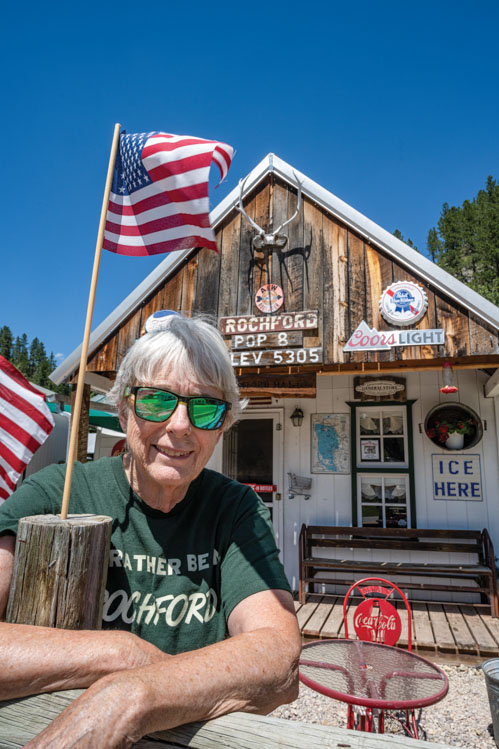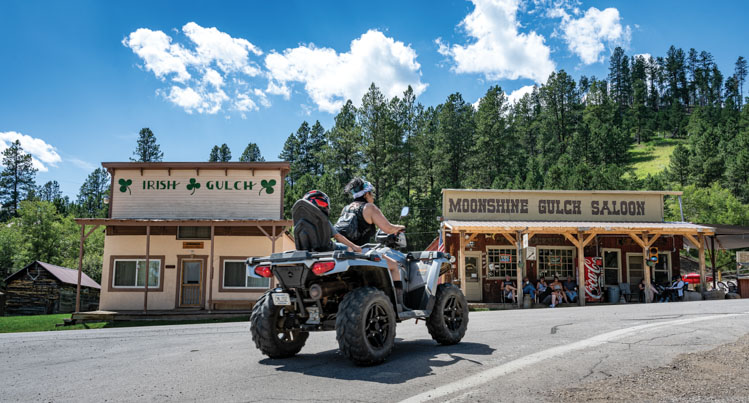The Gift of South Dakota
Subscriptions to South Dakota Magazine make great gifts!
Subscribe today — 1 year (6 issues) is just $29!
The Humor of Rochford
 |
| Colleen Langley runs the Rochford Mall, also known as the "Small of America." |
You know there’s a sense of humor in a town that boasts a shopping mall and a university, but no official population.
Rochford is a tiny burg with a couple businesses and a handful of homes at the intersection of some very rural roads in the center of the Black Hills. Its population is not tracked by the U.S. Census Bureau. Locals will think for a minute, mentally counting occupied homes, and tell you the full-time year-round population is five. On a typical summer day many more than that stop in for refreshments.
A relative latecomer amongst mining towns in the Black Hills, Rochford didn’t blossom until prospectors discovered gold near the junction of Irish Gulch, Poverty Gulch and Moonshine Gulch in 1878. Deadwood and Lead had already been roaring for two years. Prospector M.D. Rochford was one of the early residents and his name was bestowed upon the community along Rapid Creek.
Homes used for weekend, vacation and hunting getaways are the predominant structures in the Rochford area now. Bicyclists and hikers on the Mickelson Trail pass through on the former railroad line that served nearby mines. The Standby Mine was the largest and longest standing, but the fondly remembered stamp mill there fell victim to rustic scrap wood thieves and was demolished in the 1980s to prevent adventure seekers from being hurt in the building’s remains. Countless photographs and a painting by artist Jon Crane preserve the memories.
Carol Pitts’ family still enjoys her grandfather’s hunting cabin just across the creek from the former railroad tracks. “Grandfather would wake us up to wave at the train as it went by,” she recalls.
Rochford Mall proprietor Colleen Langley started the store with Jerie Rydstrom as a tent selling paintings during the Sturgis Motorcycle Rally. It soon moved into a small building, and then to a renovated 1940s gas station in 2001. Langley can’t remember who began calling the store a “mall,” but when the Mall of America in Minnesota became famous for its size, the Rochford store became the “Small of America.” The sign out front still gets a chuckle from visitors.
The “small” is one of the largest sellers of Schwan’s ice cream in the Black Hills, along with shirts, camping sundries and Langley’s artwork. It’s also the exclusive supplier of Rochford Gold Dust, a meat seasoning rub. “Once you’ve had it you can’t eat popcorn or eggs without it,” Langley says.
 |
| Most traffic through Rochford today is ATVs and UTVs. |
Linda Sandness and her husband bought property in the Rochford area in 1993 and built a retirement home. “If I’m going to live someplace, I want to know about it, so I started asking questions,” she says. That led to a partnership with Langley and Lauree Oerlline Buus to author a book called Rochford: The Friendliest Little Ghost Town in the Black Hills. Available, of course, at the “small,” the book includes many historic and contemporary photos.
Sandness enjoyed researching the tiny town. “I just love Rochford,” she says. “There was a time that it rivaled Rapid City.”
Rochford and the surrounding area’s population peaked at around 1,000 in the 1800s. There were hotels, a theater, butcher shop, two restaurants and a drug store. A U.S. Forest Service Station operated here in the early 1900s. Now the “small” and the Moonshine Gulch Saloon are the only functioning businesses, but that’s enough to keep things lively.
The saloon dates back to 1910 and also served as a livery stable, pool hall and barber shop. If you haven’t visited, you may recognize it from musicians Big and Rich’s 2005 “Big Time” video. Irish Gulch is emblazoned on a false-fronted building next door. The former dance hall is a private cabin.
Annie Tallent, the first documented white woman in the Black Hills, lived and taught in Rochford. Outside the former school, a Rochford University sign adds another touch of whimsy to the community, but the building is now a private residence, home to just some of the people who unofficially live in this tiniest of towns tucked among the pines.
Editor’s Note: This story is revised from the November/December 2023 issue of South Dakota Magazine. To order a copy or to subscribe, call (800) 456-5117.










Comments